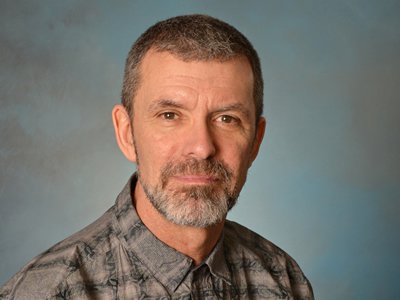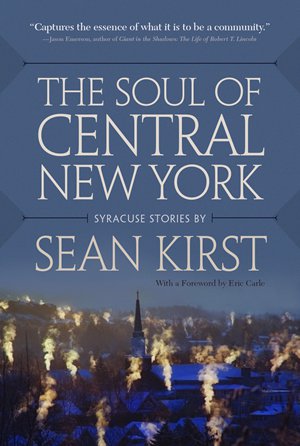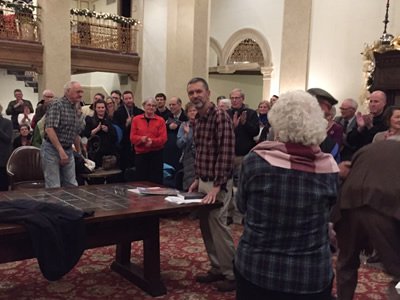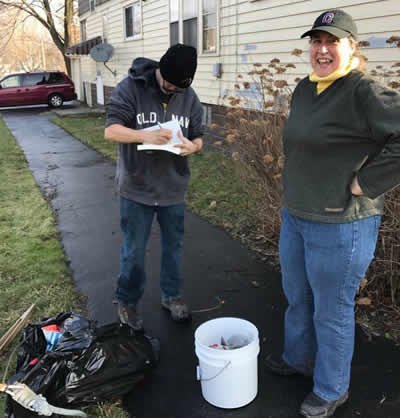Fanfare for the Common Man
Sean Kirst’s 'The Soul of Central New York' captures hopes, dreams of everyday people

The last place Pat Wiese ever imagined himself was in the pages of the Syracuse Post-Standard. In a Sean Kirst column.
“My first interaction with Sean came in the form of a phone call,” says Wiese, a Le Moyne College baseball standout who was diagnosed with bone cancer in his senior year. “I was sitting in my basement and distinctly remember hearing this rusty voice on the other end of the line. I was excited because I’ve thought highly of Sean’s work.”
Kirst and Wiese developed an immediate rapport, the latter going into details about a surgery to remove a tumor in his leg and the painful bouts of chemotherapy that followed. Eventually, the conversation turned to Wiese’s fateful encounter with a “cancer angel” at Boston’s Fenway Park during the 2013 World Series. The angel in question was Dave Mellor, the park’s longtime head groundskeeper, who let Wiese “paint” home plate and the pitcher’s mound before Game 2.
Mellor also had dreams of playing professional ball, but a freak car accident shattered his knee. He and Wiese were kindred spirits.
“As I told Sean everything, he didn’t say a word. That spoke volumes to me,” says Wiese, now a sought-after baseball instructor. “I believe Sean’s greatest gift is just being present … and listening. He understood my passion, as I spoke for what seemed like hours. Afterward, we talked baseball, dissecting the game as if we were two guys in a sandwich shop.”
The two did not meet until a year later, when Kirst was doing a follow-up story on Wiese. By then, his first column about the Fayetteville resident—aptly titled “God Puts People in Your Path” (Nov. 28, 2013)—had transformed Wiese into a local hero, driving interest in his eponymously named foundation supporting cancer research, as well as patients and their families.
The article also reaffirmed Kirst’s role as a voice for the community, a journalist capable of capturing the hopes and dreams of everyday people. When it came time to put together “The Soul of Central New York” (Syracuse University Press, 2016), a collection of Kirst’s columns spanning almost a quarter century, Wiese’s story got the nod.
“Sean was exactly as I imagined him: pen and paper, plaid shirt, jeans,” says Wiese, who, during his meeting with Kirst, threw out the first pitch at a Syracuse Chiefs home playoff game. (It was a strike.) “He screamed grit. I was automatically drawn to him, as we stood on the concourse and, again, talked baseball.”

A sense of humanity
“The Soul of Central New York” is about resilience—Kirst’s as much as anyone else’s. Culled from thousands of columns he wrote for The Post-Standard between 1991 and 2015, the collection weaves together tales of love, sorrow and hope. The result is a literary masterstroke featuring such familiar names as Vice President Joseph Biden G’68, H’09, Jim Brown ’57 and Jim Boeheim ’66, G’73 alongside quiet hometown heroes. Common to all of them is a sense of humanity—and vulnerability—making their stories instantly relatable. “They’re all on a level playing field,” Kirst says.
The original plan was to do something longer, but his editors thought otherwise. “In 2013, I gave SU Press a collection of 150 columns, and they sent it to professional readers who rightfully annihilated it; they said it was too long and felt thrown together,” recalls Kirst, 57, during a meeting at Starbucks on Marshall Street, wearing—what else?—a red plaid shirt and blue jeans. “It was humbling.”
Stroking his salt-and-pepper beard, he wistfully recalls how the project helped him adjust to life after The Post-Standard in 2015. “I finally could give it my full attention,” says Kirst, who now writes for Syracuse University and The Buffalo News. (A cursory glance at the University’s news page confirms he is its most-read author.) “My editor at the Press, Alison Maura Shay, was terrific to work with, and felt strongly about what the book needed to say. She gave it an in and an out.”
Kirst and Shay spent months wrestling over which columns to keep and discard. They eventually settled on 88 of them (less than two percent of Kirst’s total oeuvre) spread over 10 chapters. “Choosing the last few was especially hard because everything I’ve written about, everyone who has trusted me, matters in my life,” Kirst says in his gravelly baritone. “The themes [of the chapters] exemplify all the questions I’ve been trying to answer during my career.”
The result is a 400-page love letter to Central New York, replete with a foreword by Eric Carle—yes, the Eric Carle, the children’s book author who was born and raised in Syracuse; a well-turned preface and epilogue; a detailed chronology of columns; and 45 illustrations that originally appeared in The Post-Standard.
Whether one is new to Kirst’s writing or has religiously followed it over the years, “The Soul of Syracuse” is more than a greatest hits package. Janice Bullard Pieterse, author of “Our Work Is but Begun: A History of the University of Rochester, 1850-2005” (Meliora Press, 2014), praises Kirst’s extraordinary connection with his readers and subjects. “How wonderful it would be for any community to have such an artful chronicle of its poignant moments,” she says.
Adds Jason Emerson, author of “Giant in the Shadows: The Life of Robert T. Lincoln” (Southern Illinois University Press, 2012), “Kirst not only shares with readers his love and passion for the people, places and voices of his hometown, but also captures the essence of what it is to be a community.”
Indeed, “The Soul of Central New York,” Kirst's third book, offers a vivid portrait of the people defining the region. Witness a group of strangers risking death along the New York State Thruway to save a solider from a burning truck, or football legend Jim Brown waxing poetic about the legend of No. 44 at Syracuse or Vice President Biden tracing his bittersweet connection to the University.
“There’s a lot of darkness here, but there’s also a lot of hope,” admits Kirst, winner of the 2008 Scripps Howard Award (i.e., the Ernie Pyle Award) for human-interest storytelling. “How we deal with tragedy is what defines us.”

A compassionate soul
Storytelling can be big business, if done well. As of this writing, “The Soul of Central New York” is the fastest-selling title in SU Press’ 73-year history. Book-signings are coveted affairs, with readers often waiting in line for hours for the “Bard of Upstate America” (as Kirst is known to POLITICO’s Jimmy Vieklind) to grace them with a hug or an autograph. Not even a December whiteout, which ground the city to a halt, deterred some 50 people from showing up at a Barnes & Noble signing. Despite the storm raging outside, Kirst and his readers enjoyed a warm back-and-forth about the book. A second event was added a week later, with lines of people snaking around the building.
Readers also flocked to signings at the Onondaga Historical Association, in which 100 copies were snatched up within 10 minutes, and the newly renovated Marriott Syracuse Downtown (formerly the historic Hotel Syracuse). Such turnouts are an anomaly in the world of university publishing. “It’s been heartwarming, exciting and just pure fun to go on this journey with Sean, as he has brought this book to the community,” says Alice Randel Pfeiffer G’77, G’86, director of SU Press. “Sales have been through the roof. We’ve ordered our third printing in less than a month.”
The demand for product—and Kirst’s time—keeps him hopping. Upcoming events include Barnes & Noble in DeWitt on Saturday, Feb. 11, from 1-3 p.m.; the River’s End Bookstore in Oswego on Tuesday, Feb. 14, from 6-8 p.m.; and the Institute for Retired People in Syracuse’s University College on Thursday, Feb. 16, from noon-1 p.m.
SU Libraries, SU Press and the Blackstone LaunchPad are co-hosting a special program on Friday, Feb. 24, from 3-5 p.m., featuring author remarks and a panel discussion, followed by a signing and reception.
No one is more surprised at all the fuss than Kirst himself. “Leaving The Post-Standard was very painful for me,” he says, leaning forward with a cup in hand. “I had built up an intense relationship with the community. After being away from my column for a while, I wasn’t sure what people still thought of me.”
Kirst pauses to consider how much time has passed since that warm November morning in 2015, when he sat down to write his farewell column, lavishing praise upon his readers. “You are a treasure, as is this town,” he famously wrote. The intervening months have been revelatory. Given time to think, Kirst has developed a new appreciation for what he deems the essence of his craft: sharing the struggles and triumphs of everyday people. “It is a journey I will follow for the rest of my career, in whatever form it takes—whether as columns, narrative writing, public speaking or as books,” he continues.
Shay, the Press’ acquisitions editor, echoes these sentiments, calling Kirst a master storyteller. “The people of Central New York have been exceedingly generous in entrusting Sean with their stories,” she says. "Through each beautifully composed story—of triumph and sadness, of the everyday and the unusual—he introduces readers to some of the incredible individuals who make up our community.”
One of them is Thelma Bonzek ’43, who helped her husband, Joe, locate the survivors of Jesse Gallardo, a fellow soldier killed on a French mountainside during World War II. Years later, the Bonzeks traced Gallardo’s brother, Francis, to an Ohio nursing home, the circumstances surrounding Jesse’s death still unknown to Francis. “It was an emotional phone call,” recalls Thelma, a 93-year-old Syracuse native. “Joe and Jesse were best friends during the war. He carried [Jesse’s] body down the mountain, after he was killed.”
Although Joe died three years later, his legacy—and Jesse’s—is intact, thanks to Kirst’s storytelling. Bonzek says people like Kirst are a vanishing breed. “I can tell what I need to know about someone in five minutes,” she says. “I knew right away with Joe, and we were married for 65 years. I also have known with Sean because, when he talks to me, he looks me in the eye. He’s an honest, compassionate soul.”
Chris Couse also attests to these qualities. His grandparents, Leonard and Rose Mancini, were the subject of an early Kirst piece titled “A Couple Walks Side by Side to the Last Step” (July 2, 1994). Couse recalls contacting Kirst many years after the column appeared. “I asked him if he remembered the story and if it might be archived somewhere,” Couse says. “Not only did Sean remember the story, but he remembered how it moved him. He promptly sent me a copy of the article. I couldn’t thank him enough.”
Couse still has no idea how Kirst found out about his grandparents, but knows that the writer interviewed his mother, aunt and uncle for the article. “It’s a touching story, even more so for those of us lucky enough to call these beautiful people ‘family,’” Couse adds.

Breaking down walls
An Upstate journalist since 1974, Kirst espouses the blue-collar values of many of the people in his book. His professional career began at age 14, when he worked as a stringer with the Dunkirk Evening Observer, near Buffalo. “I did a little bit of everything, but really loved covering sports,” Kirst says, adding that he has a baseball novel that is 90-percent done. “I’m particularly moved by great baseball writing. To me, it's always offered a chance to catch real elements of a larger American experience."
After earning a bachelor’s degree in English from SUNY Fredonia, Kirst worked briefly in Rochester and Niagara Falls, and then moved to The Post-Standard in 1988. He developed a reputation for being honest and fair, part of an old guard of journalists driven by the quest for truth. “Whether I was writing about major news events or human-interest stories, I tried to focus on the daily trials and triumphs that we all can appreciate. I was lucky that people trusted me with those stories,” he says, citing Dan Barry, Studs Terkel and Jimmy Breslin as influences, along with many Upstate journalists he followed as a youth. "The issue is maintaining a line of objectivity, even when writing about powerful, emotional issues."
Kirst explains that “The Soul of Central New York” is as much a portraiture as it is an homage to his fellow denizens. “I am deeply appreciative for everything I’ve learned from countless great journalists at Syracuse.com and The Post-Standard,” he says. “They gave me so many opportunities there.”
Former editor Richard Sullivan marvels at how Kirst—raised in a factory family, amid change and civic disintegration—weaves together love, hope and passage in an avuncular way. “The success of Sean’s book sends a message: People miss Sean, and they miss this kind of journalism,” he says, speaking by phone from his home in San Diego. “Sean is an icon not just because he’s a great writer and a great reporter, but also because he’s one of us. He sits and talks with people. Genuinely listens to them. He has a way of engaging readers, without preaching to them.”
This is because Kirst often comes at a story from a different place, quite literally. “At a news event, Sean never stood with the pack,” Sullivan adds. “He always would be off to the side, watching and listening. This gave Sean and his readers a different perspective on the event.”
As Kirst writes the next chapter of his career, he no doubt will keep a forensic eye on the divisions and rivalries that have pushed Syracuse—and the United States—toward a sense of civic twilight. Such sensitivity is his wheelhouse. “The best part about Sean’s book is that every one of his stories connects to a resident of Syracuse, one way or another,” Wiese says. “If you hand the book to a passerby in Syracuse and ask him to read it, I guarantee you that he will have a tie, directly or indirectly, to someone in it. Writing is Sean’s way of building community.”
Kirst, for one, hopes Wiese is right, as “The Soul of Central New York” admittedly has been a hard-fought win. “Working on it has taught me a lot about other people, and about myself,” Kirst says, running his hands through his close-cropped dark hair. “Whether you live in Cicero or on Syracuse’s South Side, there are fundamental things that unite all of us—holding a baby in your arms, comforting a sick child, saying goodbye to a parent. I want to break down walls by capturing these moments, these snapshots in time. This is my life's work, and it's never done.”
